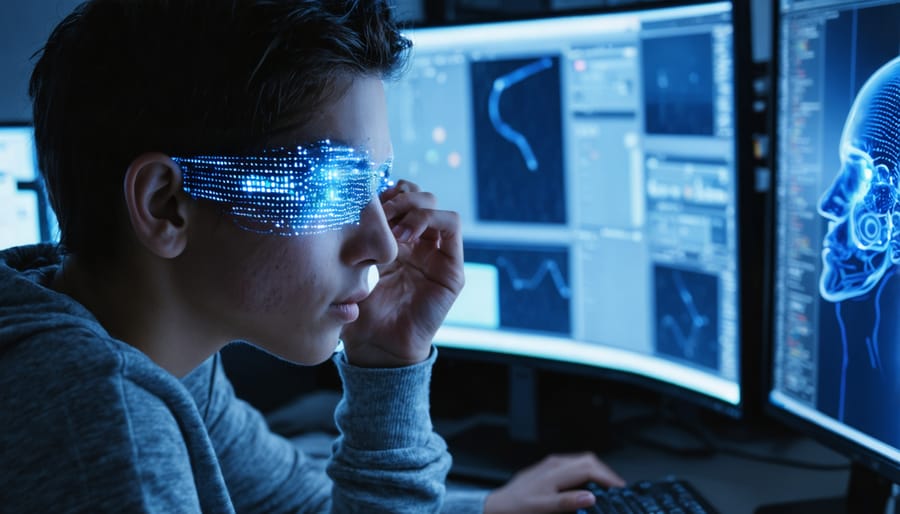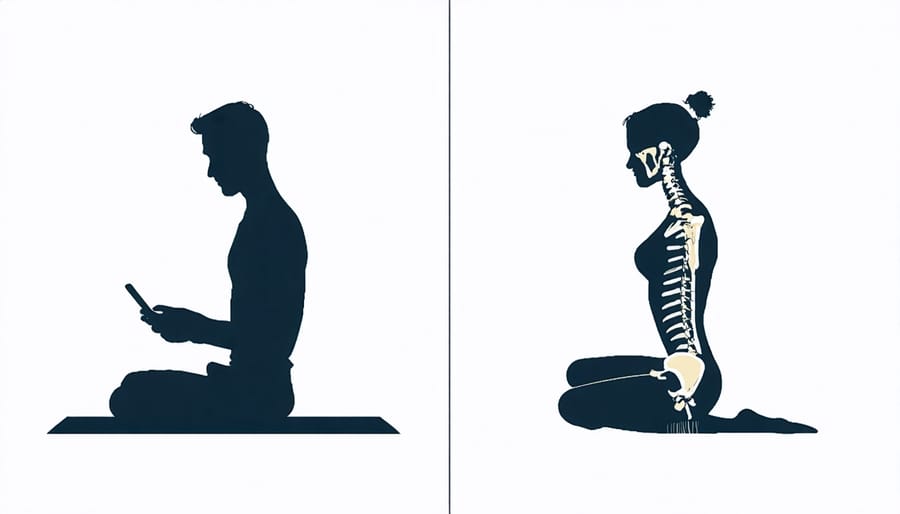Technology has revolutionized our lives, but its impact on our health deserves serious attention. From digital eye strain and chronic neck pain to anxiety and sleep disorders, our increasing dependence on screens and devices is taking a measurable toll on our physical and mental well-being. Recent studies show that the average Canadian spends over 11 hours daily interacting with technology, leading to a surge in technology-related health issues across all age groups.
While innovation continues to advance at a remarkable pace, healthcare professionals are raising urgent concerns about how our tech habits affect our bodies and minds. This comprehensive guide examines the ten most significant ways technology compromises our health, backed by current research and expert insights. More importantly, we’ll explore practical strategies to protect ourselves while still benefiting from the digital tools that have become essential to modern life.
Understanding these health risks isn’t about rejecting technology – it’s about creating a healthier relationship with our devices to safeguard our well-being for years to come.
Physical Health Impacts
Digital Eye Strain and Vision Problems
The increasing use of digital devices has led to a significant rise in digital eye strain, affecting many Canadians who spend long hours looking at screens. Common symptoms include dry eyes, blurred vision, headaches, and neck pain. Research shows that prolonged exposure to blue light from screens can disrupt sleep patterns and potentially contribute to long-term vision problems.
To protect your eyes while using digital devices, eye care professionals recommend following the 20-20-20 rule: every 20 minutes, take a 20-second break to look at something 20 feet away. Proper screen positioning is also crucial – keep your device at arm’s length and slightly below eye level to reduce strain.
Consider adjusting your device settings by increasing text size, reducing screen brightness, and enabling night mode when available. Using artificial tears can help combat dry eyes, while anti-glare screens and blue light filtering glasses may provide additional protection.
Regular comprehensive eye examinations are essential for maintaining eye health, especially if you frequently use digital devices. Remember to blink often and ensure proper lighting in your workspace to minimize eye strain.

Poor Posture and Musculoskeletal Issues
The way we interact with our devices is taking a significant toll on our bodies. Many Canadians spend hours hunched over smartphones, tablets, and computers, leading to what health professionals now call “tech neck” – a strain injury caused by looking down at screens for extended periods. This unnatural position puts excessive pressure on the spine, potentially leading to chronic neck and upper back pain.
Poor posture while using technology doesn’t just affect the neck. Extended periods of sitting with improper ergonomics can result in lower back pain, shoulder tension, and wrist problems like carpal tunnel syndrome. The repetitive motions associated with typing and scrolling can cause inflammation in joints and tendons, particularly in the hands and fingers.
Children and teenagers are especially vulnerable to these issues as their bodies are still developing. Studies show that early exposure to poor tech-related posture habits can lead to long-term musculoskeletal problems.
To minimize these risks, maintain proper posture by keeping screens at eye level, taking regular movement breaks, and setting up an ergonomic workspace. Simple stretching exercises and posture awareness can help prevent many of these technology-related physical ailments.

Sedentary Behavior and Weight Gain
The rise in screen time and digital device usage has led to a concerning increase in sedentary behavior among Canadians. While modern technology offers numerous benefits, excessive sitting and reduced movement have become significant health concerns. Studies show that adults who spend more than 6 hours daily on digital devices are more likely to experience unwanted weight gain and associated health risks.
The relationship between physical activity with technology use and weight management is clear: prolonged sitting while using devices reduces calorie burning and can lead to poor posture and decreased metabolism. This is particularly concerning when screen time replaces activities that would typically involve movement, such as walking, playing sports, or engaging in household tasks.
To counter these effects, try implementing the 20-20-20 rule: every 20 minutes, take a 20-second break and move at least 20 steps away from your screen. Setting movement reminders, using standing desks, and scheduling regular exercise breaks can help maintain a healthy weight while still enjoying the benefits of technology. Remember, the goal isn’t to eliminate technology use but to create a balanced approach that supports both digital connectivity and physical well-being.
Sleep Disruption
The pervasive use of electronic devices is significantly impacting our sleep patterns and overall rest quality. The blue light emitted by smartphones, tablets, and computers interferes with our body’s natural production of melatonin, the hormone responsible for regulating our sleep-wake cycle. This disruption can lead to difficulty falling asleep, reduced sleep quality, and daytime fatigue.
Studies show that using devices before bedtime can delay sleep onset by up to 60 minutes and decrease the amount of restorative REM sleep we get during the night. The constant notifications and alerts from our devices can also trigger stress responses, making it harder to achieve deep, restful sleep.
To protect your sleep quality, consider implementing a “digital sunset” one hour before bedtime. During this time, switch off all electronic devices and engage in calming activities like reading a physical book or practicing relaxation exercises. Using night mode settings on devices and maintaining a consistent sleep schedule can also help minimize technology’s impact on your circadian rhythm.
Remember that quality sleep is essential for mental clarity, emotional well-being, and physical recovery. Making small adjustments to your technology use in the evening can lead to significant improvements in your sleep patterns.
Mental Health Consequences
Digital Addiction and Dependency
Digital addiction has become increasingly prevalent in Canadian society, characterized by compulsive device use and anxiety when separated from technology. Many individuals find themselves constantly checking their phones, scrolling through social media, or feeling uneasy without internet access. While smart health tracking tools can benefit our wellbeing, excessive screen time can lead to dependency and negative behavioral patterns.
Common signs of digital addiction include difficulty concentrating on tasks without checking devices, neglecting real-world relationships, and using technology to cope with stress or emotions. This dependency can result in disrupted sleep patterns, increased anxiety, and decreased productivity. Studies show that excessive screen time triggers dopamine releases similar to other addictive behaviors, making it challenging to maintain healthy boundaries with technology.
To manage digital dependency, consider implementing designated tech-free times, using app limits, and engaging in alternative activities like exercise or outdoor recreation. Creating mindful technology habits and maintaining face-to-face connections can help restore balance and protect mental health while still benefiting from digital tools when used appropriately.
Anxiety and Depression
The increasing prevalence of technology in our daily lives has been linked to higher rates of anxiety and depression, particularly among young adults and teenagers. Research shows that excessive screen time and constant connectivity can trigger stress responses in the brain, disrupting natural emotional regulation patterns.
Social media use, specifically, has been associated with feelings of inadequacy, FOMO (fear of missing out), and decreased self-esteem. The constant comparison to carefully curated online personas can lead to negative self-perception and heightened anxiety levels. Additionally, the dopamine-driven feedback loops created by likes, comments, and notifications can contribute to addictive behaviors and mood fluctuations.
Late-night technology use can interfere with sleep quality, which is crucial for maintaining good mental health. The blue light emitted from screens disrupts our natural circadian rhythm, potentially exacerbating symptoms of both anxiety and depression.
To protect your mental well-being, consider implementing digital boundaries such as designated tech-free times, regular digital detoxes, and turning off notifications during rest periods. Engaging in outdoor activities, face-to-face social interactions, and mindfulness practices can help counter the negative mental health impacts of excessive technology use.
Social Isolation
While technology enables us to stay connected virtually, excessive screen time can lead to significant social isolation in real life. Studies show that Canadians who spend more than 6 hours daily on digital devices are more likely to experience decreased face-to-face interactions and weakened social bonds.
This digital dependency can impair the development of crucial social skills, particularly in children and young adults. Regular online communication, while convenient, often lacks the depth and emotional nuances present in in-person interactions. People may find it increasingly difficult to read body language, maintain eye contact, or engage in meaningful conversations.
The comfort of virtual connections can create a false sense of social fulfillment, leading many to withdraw from real-world social activities. This isolation can contribute to feelings of loneliness, anxiety, and depression. Research indicates that individuals who prioritize online interactions over real-world relationships are at higher risk of developing mental health issues.
To maintain healthy social connections, consider setting boundaries for device usage and actively seeking out face-to-face interactions. Join community groups, schedule regular meetups with friends, or participate in group activities that encourage personal interaction.
Attention Span and Cognitive Function
The constant use of digital devices has significantly impacted our ability to focus and process information effectively. Research shows that frequent technological interruptions, such as notifications and multitasking between apps, can reduce attention span and make it harder to concentrate on single tasks for extended periods.
Studies indicate that excessive screen time can lead to decreased memory retention and cognitive processing speed. The habit of quickly switching between tasks – like checking social media while working – can create a pattern of scattered thinking that makes deep focus more challenging over time.
Digital distractions can also affect our brain’s ability to filter important information from noise, potentially leading to decision-making difficulties and reduced productivity. Young adults who spend more than six hours daily on digital devices often report difficulties with sustained attention and mental fatigue.
To protect cognitive function, consider implementing regular digital breaks, practicing mindful single-tasking, and setting specific times for technology use. Creating technology-free zones and periods can help restore natural attention patterns and improve mental clarity. Simple activities like reading physical books or engaging in face-to-face conversations can help strengthen focus and cognitive abilities.
Practical Solutions and Healthy Tech Habits
Digital Wellness Tools and Settings
Modern devices come equipped with various features to support digital wellness and healthier technology use. iOS and Android devices offer screen time tracking and app limits, allowing you to set daily usage restrictions for specific applications. Night mode or blue light filters help reduce eye strain and sleep disruption by automatically adjusting screen colours during evening hours.
Many smartphones now include “Focus” or “Do Not Disturb” modes that minimize notifications and interruptions during specific times. Digital wellbeing dashboards provide insights into your technology habits, helping you make informed decisions about your device usage.
Popular apps like Forest and Space encourage mindful technology use by gamifying digital breaks. Built-in parental controls allow families to manage children’s screen time effectively. Some devices also feature ergonomic reminders that prompt users to maintain proper posture and take regular breaks.
Consider enabling these tools and customizing them to your needs. Start with one or two features and gradually incorporate others as you develop healthier technology habits.

Physical Health Protection Strategies
To protect your physical health while using technology, implement these proven strategies in your daily routine. Start by setting up an ergonomic workspace with your screen at eye level and about arm’s length away. Your chair should support your lower back, and your feet should rest flat on the floor or a footrest.
Practice the 20-20-20 rule to reduce eye strain: every 20 minutes, look at something 20 feet away for 20 seconds. This simple habit helps prevent digital eye fatigue and maintains healthy vision.
Incorporate regular movement breaks throughout your day. Set a timer to remind yourself to stand up and stretch every hour. Try simple desk exercises like shoulder rolls, wrist stretches, and neck rotations. Taking short walks during phone calls or between virtual meetings can help maintain circulation and reduce muscle tension.
Consider using a standing desk for part of your workday, but transition gradually to avoid muscle fatigue. When using mobile devices, hold them at chest level to prevent neck strain, and alternate between hands to distribute the load evenly.
Remember to maintain proper posture while using devices: keep your shoulders relaxed, wrists straight, and head balanced over your spine. Using voice commands and dictation features can help reduce repetitive hand movements and prevent strain injuries.
These small adjustments can make a significant difference in preventing technology-related physical health issues while maintaining productivity.
Mental Health Preservation Techniques
While technology has become an integral part of our lives, maintaining good mental health requires conscious effort and balanced habits. Start by establishing clear boundaries with your devices, such as designating tech-free zones in your home and setting specific times for checking emails and social media.
Practice the 20-20-20 rule: every 20 minutes, take a 20-second break and look at something 20 feet away. This simple technique helps reduce digital eye strain and provides brief mental refreshment. Additionally, implement regular “digital detox” periods, whether it’s a few hours each evening or a full weekend day, to reconnect with offline activities and relationships.
Mindfulness exercises can significantly help in managing technology-related stress. Try deep breathing exercises when you feel overwhelmed by notifications, or practice mindful browsing by being conscious of your online time and purpose. Consider using apps that promote mental wellness through guided meditation or mood tracking, but be mindful of not becoming overly dependent on them.
Create a healthy bedtime routine by avoiding screens at least one hour before sleep. Instead, engage in calming activities like reading a physical book, journaling, or light stretching. Enable blue light filters on your devices and maintain consistent sleep schedules to support your natural circadian rhythm.
Remember to nurture real-world connections and hobbies that don’t involve screens. Regular exercise, outdoor activities, and face-to-face social interactions are essential for maintaining psychological well-being in our increasingly digital world.
While technology has become an integral part of our daily lives, being aware of its potential health impacts empowers us to make better choices. From digital eye strain and poor posture to sleep disruption and mental health challenges, these effects remind us to prioritize our wellbeing. The good news is that we can minimize these risks through mindful technology use. By taking regular breaks, maintaining proper ergonomics, setting digital boundaries, and practicing healthy tech habits, we can continue to benefit from technology while protecting our health. Remember, technology should enhance our lives, not compromise our wellbeing. Start implementing these protective strategies today, and encourage your loved ones to do the same. Together, we can create a healthier relationship with our digital devices.

